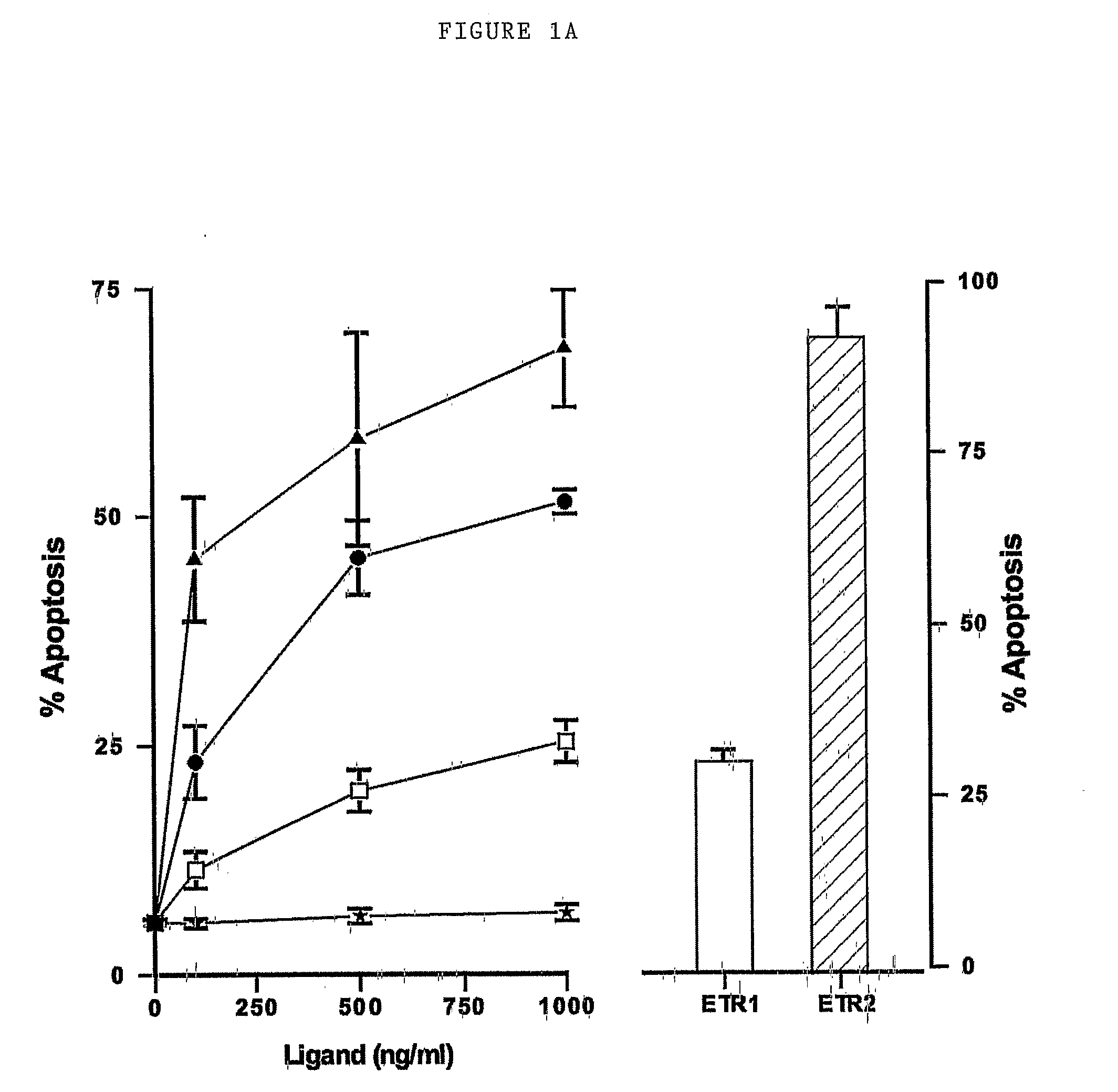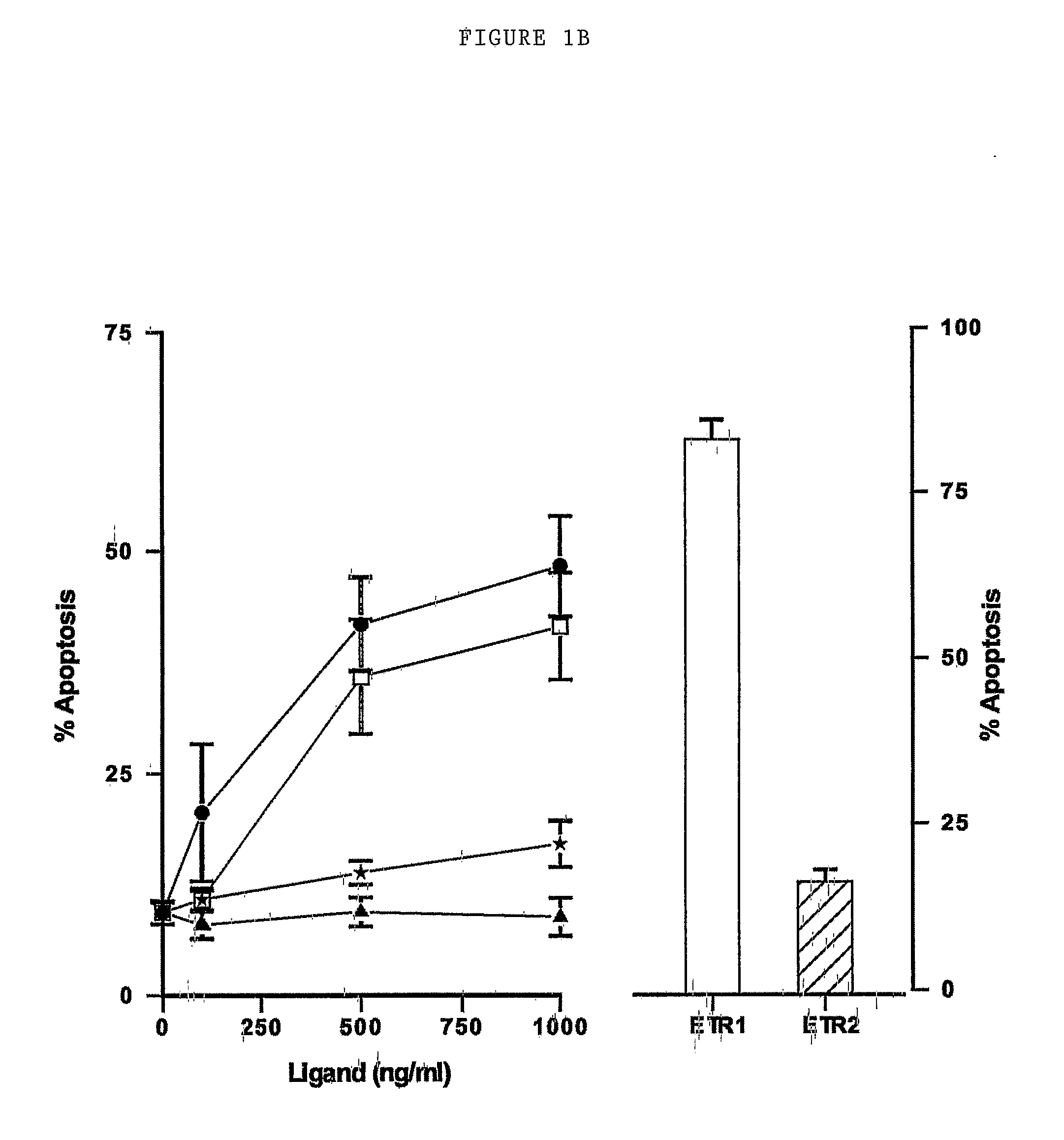Receptor-specific tumour necrosis factor-related apoptosis-inducing ligand (TRAIL) variants
a tumour necrosis factor and receptor-specific technology, applied in the field of tumour necrosis factor(tnf) related apoptosis-inducing ligand (trail), can solve the problems of no teaching of dr4 selectivity, no liver toxicity, studies have been performed, etc., to reduce or eliminate liver toxicity and increase the binding effect of dr4
- Summary
- Abstract
- Description
- Claims
- Application Information
AI Technical Summary
Benefits of technology
Problems solved by technology
Method used
Image
Examples
example 1
Exemplary and Comparitive TRAIL Mutant Sequences
[0211]The following table shows wild-type TRAIL sequence at selected positions compared to prior art (‘Genentech’) and TRAIL mutants of the invention. Particularly preferred TRAIL mutants of the invention are TRAIL.R1-4 and TRAIL.R1-5.
189191193199201209213215WtYRQNKYYSGenentechARSVRYWD(= FLAG-Apo2L.DR4-8)TRAIL.R1-5YRSVRYWDTRAIL.R1-4YRQVRYWD
[0212]Furthermore, the TRAIL mutants of this example are longer than the prior art mutants since they contain residues 95-281 of TRAIL, and the Genentech version comprises only residues 114-281.
[0213]The TRAIL.R1-5 mutant only differs from the Genentech mutant at one amino acid (=residue 189). The mutant of the invention retains the wild type tyrosine whilst the Genentech mutant has an alanine substitution. The Genentech mutant shows selective binding for TRAIL R1 (DR4) by in vitro binding assays, but has no signalling activity in cells that signal via R1.
[0214]We show that although the Genentech mut...
example 2
TRAIL Receptor Selective Mutants Signal to Apoptosis via TRAIL-R1 in Primary Lymphoid Malignancies
[0216]Overview
[0217]Based on studies using agonistic monoclonal antibodies (Mabs), we demonstrate that primary chronic lymphocytic leukemia (CLL) cells appear to signal primarily through TRAIL-R1 despite expressing TRAIL-R2 on the cell surface. We have synthesized mutant forms of TRAIL specific for TRAIL-R1 or TRAIL-R2. The selectivity of these mutants to induce apoptosis in cell lines is due to their selective binding to their cognate receptors resulting in apoptosis via formation of a death inducing signaling complex (DISC). Using these mutants we conclusively demonstrate that CLL and mantle cell lymphoma cells signal apoptosis almost exclusively through TRAIL-R1. These data confirm that the two TRAIL death receptors can signal independently and show that DR4 receptor-specific mutant forms of TRAIL have therapeutic applications.
[0218]Apoptotic Activity of TRAIL Receptor Selective Muta...
example 3
TRAIL-R1 but not TRAIL-R2 Selective Mutants Induce Apoptosis in Cancer Cells
[0227]The cancer cells of this example are those of haematopoietic malignancies such as CLL cells and MCL cells. We disclose that TRAIL induces apoptosis in CLL cells by signaling through TRAIL-R1 but not TRAIL-R2. The synthesis of selective TRAIL mutants enables us to demonstrate this point unequivocally. Depsipeptide sensitized CLL cells to TRAIL-induced apoptosis (FIG. 2C). Most importantly depsipeptide also sensitized CLL cells to TRAIL.R1-5, the TRAIL-R1 selective mutant, but not to TRAIL.R2-6, the TRAIL-R2 selective mutant (FIG. 2C). Furthermore depsipeptide sensitized CLL cells to HGS-ETR1, the agonistic TRAIL-R1 Ab but not to HGS-ETR2, the TRAIL-R2 agonistic Ab (FIG. 2C).
[0228]We also obtained three samples from patients with mantle cell lymphoma (MCL), an incurable and aggressive disease that accounts for ˜6% of all non-Hodgkin's lymphoma. There are no standard treatments for MCL and the prognosis i...
PUM
| Property | Measurement | Unit |
|---|---|---|
| concentration | aaaaa | aaaaa |
| concentrations | aaaaa | aaaaa |
| concentrations | aaaaa | aaaaa |
Abstract
Description
Claims
Application Information
 Login to View More
Login to View More - R&D
- Intellectual Property
- Life Sciences
- Materials
- Tech Scout
- Unparalleled Data Quality
- Higher Quality Content
- 60% Fewer Hallucinations
Browse by: Latest US Patents, China's latest patents, Technical Efficacy Thesaurus, Application Domain, Technology Topic, Popular Technical Reports.
© 2025 PatSnap. All rights reserved.Legal|Privacy policy|Modern Slavery Act Transparency Statement|Sitemap|About US| Contact US: help@patsnap.com



